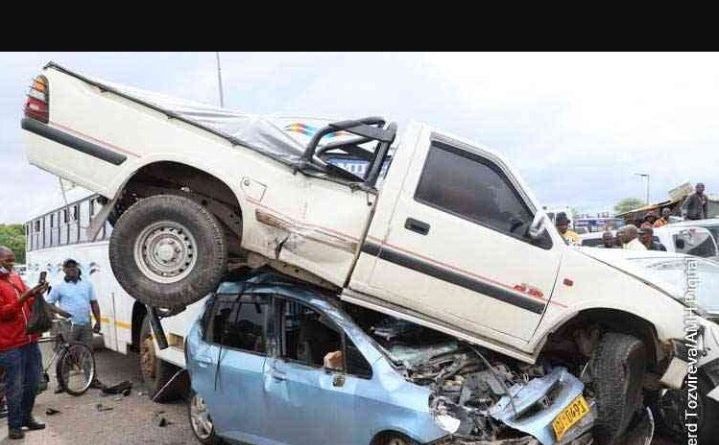Road traffic accidents jump to 28 159 in first six months…Harare’s roads the worst death traps
THE horrific crash along Seke Road on Tuesday that left 17 people dead, including two pedestrians, has yet again drawn attention to what is increasingly becoming a national emergency.
The tragedy, involving a commuter omnibus and a haulage truck, was not an isolated event.
It fits into a broader, more disturbing trend. Road traffic accidents across the country, and particularly in Harare, are climbing at an alarming rate.
During the first six months of the year, Zimbabwe recorded 28 159 road traffic accidents, up from 25 968 during the same period last year, data from the Zimbabwe Republic Police (ZRP) shows.
This represents a rise of 2 191 accidents.
More concerning, however, is the jump in fatal crashes, from 784 to 870 (an 11 percent jump), and road deaths, which increased from 1 037 to 1 088 (up by 4,9 percent).
While it might seem the number of those injured dropped by 5,6 percent during the January-June period, from 5 856 to 5 525, the trend could suggest that the nature of the country’s road accidents is becoming more deadly.
The gravity of the situation is further highlighted by a trend which shows that the last quarter (April to June 2025) was the worst across all major indicators — road traffic accidents, fatal crashes, deaths and injuries.
During the first half of this year, road traffic accidents rose sharply from 12 808 during January to March to 15 350 in the three months to June, a 19,8 percent rise.
Fatal crashes jumped by 30,1 percent, from 378 in the first quarter to 492 in the second quarter, with the highest number recorded in June (169).
Correspondingly, the number of people killed rose from 464 in the first quarter to 624 in the second quarter, a 34,4 percent increase, with May (215 deaths) being the deadliest month.
Injuries also rose from 2 599 in the first quarter to 2 926 in the second quarter, a 12,5 percent increase, and peaking at 1 068 in June.
This suggests a worsening road safety crisis.
Review of fines and penalties
Police are advocating for an upward review of traffic fines.
“The fines somehow appear ‘affordable’, hence not deterrent enough to the extent that violators are somehow motivated to repeat bad practices,” said the ZRP’s chief staff officer for the Electronic Traffic Management System, Commissioner Gift Hlabiso, at the National Road Safety Indaba last week.
Deterrent traffic fines may help in reducing road traffic accidents, given that most cases arise due to bad driving behaviour.
“Ninety-four percent of road crashes are attributable to human error,” the Traffic Safety Council of Zimbabwe has said.
This is also confirmed by data from the draft Harare Master Plan (2025-2045).
“Between 2020 and 2024, the leading seven causes of road traffic accidents in Harare revolved around the driver,” reads part of the master plan.
“Out of a total of 91 133 road traffic accidents recorded incidences, driver-related factors including tailgating, misjudgement, turning errors, parking errors and speeding contributed to a combined statistic of 99,2 percent.”
Interestingly, road infrastructure issues contributed just 0,1 percent to road traffic accidents.
Meanwhile, although the ZRP statistics do not give a geospatial distribution of the numbers, findings from the draft Harare master plan reveal that Zimbabwe’s capital is particularly dangerous for drivers and pedestrians.
Harare: The epicentre of driving mischief
Data from the draft Harare master plan show that accidents in the city recorded a spike in 2022 and maintained that high level as at the end of 2024.
“The annual number of road traffic accidents increased exponentially by 87,5 percent from 12 089 in 2021 to 22 670 in 2022 and maintained a high statistic above 21 000,” reads part of the master plan.
From the peak of 22 670 in 2022, road traffic accidents in Harare declined slightly to 21 878 in 2023 and rose to 22 459 in 2024.
Based on the average of 2022, 2023 and 2024 statistics and with an estimated population of around 1,84 million, this translates to a traffic accident rate of 12,1 per 1 000 people, which is a very high figure for Harare’s size.
The master plan also notes that the majority of accidents in the city occur in known danger zones such as Seke Road, Simon Mazorodze Road and Kirkman Road.
“Across the five-year period, the majority of accidents were observed to be occurring in the Harare CBD (central business district), along Kirkman Road, Bulawayo Road, Borrowdale Road, Seke Road, Mutare Road, Simon Mazorodze Road, Willowdale Road and in the high-density suburbs of Kuwadzana, Budiriro, Highfield and Glen View.”
It was also noted that most accidents occurred from 7am to 8am and evening peak periods, 4pm to 7pm, which aligns with commuter congestion and erratic driving by operators of public transport, including mishikashika, rushing to maximise their daily takings.
The trends are unmistakable.
While Zimbabwe, and its capital in particular, is on a dangerous trajectory in terms of road safety, increased driver discipline on the roads can be the quickest way to reverse the road traffic accident crisis given that over 90 percent of crashes are caused by reckless driving.
The Government has commenced the rollout of a Smart Traffic Management System in Harare and Bulawayo, aimed at enforcing traffic rules, thereby curbing road carnage. Last month, Cabinet approved TelOne (Private) Limited’s Safe City Project’s locally developed Smart Traffic Management System.
The Sunday Mail and Traffic Safety Council of Zimbabwe will host the second Safe Driving Campaign and Conference in Harare on Friday.




